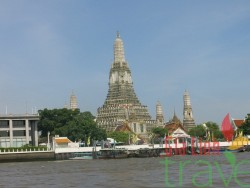Bangkok
Thailand History


Chao Phraya River

Ayutthaya
Throughout its 800-year history, Thailand can boast the distinction of being the only country in Southeast Asia never to have been colonized. Its history is divided into five major periods
Nanchao Period (650-1250 A.D.)
The Thai people founded their kingdom in the southern part of China, which is Yunnan, Kwangsi and Canton today. A great number of people migrated south as far as the Chao Phraya Basin and settled down over the Central Plain under the sovereignty of the Khmer Empire, whose culture they probably accepted. The Thai people founded their independent state of Sukhothai around 1238 A.D., which marks the beginning of the Sukhothai Period
Sukhothai Period (1238-1378 A.D.)
Thais began to emerge as a dominant force in the region in the13th century, gradually asserting independence from existing Khmer and Mon kingdoms. Called by its rulers “the dawn of happiness”, this is often considered the golden era of Thai history, an ideal Thai state in a land of plenty governed by paternal and benevolent kings, the most famous of whom was King Ramkamhaeng the Great. However in 1350, the mightier state of Ayutthaya exerted its influence over Sukhothai.
Ayutthaya Period (1350-1767)
The Ayutthaya kings adopted Khmer cultural influences from the very beginning. No longer the paternal and accessible rulers that the kings of Sukhothai had been, Ayutthaya’s sovereigns were absolute monarchs and assumed the title devaraja (god-king). The early part of this period saw Ayutthaya extend its sovereignty over neighboring Thai principalities and come into conflict with its neighbours, During the 17th century, Siam started diplomatic and commercial relations with western countries. In 1767, a Burmese invasion succeeded in capturing Ayutthaya. Despite their overwhelming victory, the Burmese did not retain control of Siam for long. A young general named Phya Taksin and his followers broke through the Burmese and escaped to Chantaburi. Seven months after the fall of Ayutthaya, he and his forces sailed back to the capital and expelled the Burmese occupation garrison.
Thon Buri Period (1767-1772)
General Taksin, as he is popularly known, decided to transfer the capital from Ayutthaya to a site nearer to the sea which would facilitate foreign trade, ensure the procurement of arms, and make defense and withdrawal easier in case of a renewed Burmese attack. He established his new capital at Thon Buri on the west bank of the Chao Phraya River. The rule of Taksin was not an easy one. The lack of central authority since the fall of Ayutthaya led to the rapid disintegration of the kingdom, and Taksin’s reign was spent reuniting the provinces.
Rattanakosin Period (1782 – the Present)
After Taksin’s death, General Chakri became the first king of the Chakri Dynasty, Rama I, ruling from 1782 to 1809. His first action as king was to transfer the royal capital across the river from Thon Buri to Bangkok and build the Grand Palace. Rama II (1809-1824) continued the restoration begun by his predecessor. King Nang Klao, Rama III (1824-1851) reopened relations with Western nations and developed trade with China. King Mongkut, Rama IV, (1851-1868) of “The King and I” concluded treaties with European countries, avoided colonialization and established modern Thailand. He made many social and economic reforms during his reign.
King Chulalongkorn, Rama V (1869-1910) continued his father’s tradition of reform, abolishing slavery and improving the public welfare and administrative system. Compulsory education and other educational reforms were introduced by King Vajiravudh, Rama VI (1910-1925). During the reign of King Prajadhipok (1925-1935), Thailand changed from an absolute monarchy to a constitutional monarchy. The king abdicated in 1933 and was succeeded by his nephew, King Ananda Mahidol (1935-1946). The country’s name was changed from Siam to Thailand with the advent of a democratic government in 1939. The present monarch, King Bhumibol Adulyadej, is King Rama IX of the Chakri Dynasty, who has reigned for more than half a century, making him the longest reigning Thai monarch.
